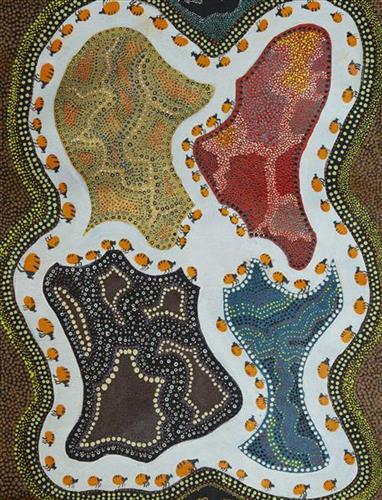111582384766
Wuukurta (Honey Ants)
“This one is the wuukurta (honey ants), I painted this one for my little boy. At night, I ring up my partner, she said ‘we going for honey ants’, they been find a big mob. Late at night, all the other prisoners said they saw a little boy walking around. And I had a dream, I saw a big star falling down – and a little boy was playing around while I was sleep. [Then] when I got out of prison, my sister-in-law- rang me up and said ‘you’ll find her in hospital, she pregnant’.
I was shock I couldn’t say anything, just looking at him. Then I saw his stripes on his back [and I knew], he must be connected with that wuukurta (honey ant).”
– Patrick Williams
Wuukurta (honey ants) are found in a variety of arid or semiarid environments, with nests of up to two metres deep and more than two metres across. Wuukurta are a highly sought after bush tucker, known otherwise as ‘bush lollies’ due to their sweet, honey like taste. They are eaten whilst still alive by holding the head and legs between two fingers and biting off the thorax. Martu dig for wuukurta nests through the seasons, but they are known to be especially abundant following the rains.
During the pujiman (traditional, desert dwelling) period, Martu would traverse very large distances annually in small family groups, moving seasonally from water source to water source, and hunting and gathering bush tucker as they went. Whilst desert life has moved away from mobile hunter-gatherer subsistence throughout the course of the twentieth century, bush tucker continues to be a significant component of the modern Martu diet. Hunting and gathering bush tucker remains equally valuable as an important cultural practice that is passed on intergenerationally. Though hunting and gathering implements have been modernised, methods of harvesting, tracking and the use of fire burning to drive animals from their retreats are still commonly practiced today.




